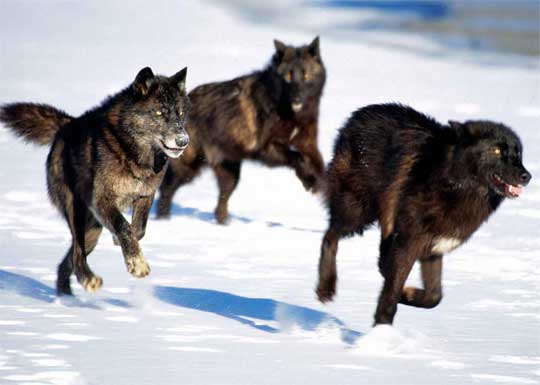

Wolf packs hunt together as a team. The pack combines the strength of many wolves, making it possible for them to hunt large animals. Statistically wolves are not successful hunters. Many more animals escape than are caught. (http://www.wolfsource.org/?page_id=70) Wolves are primarily nocturnal animals that avoid the heat of day.
They generally commence hunting at dusk. Wolves detect prey by three primary means, sent (most common), tracking, and chance encounters. After prey is detected, wolves may split up to search through brush, travel on ridge tops searching for the prey below, or test herds looking for signs of weakness.
The Alpha wolf will eat first, Wolves usually begin to feed on the rump, if it was exposed during the chase, or else on the internal organs. The muscle and flesh is the last portion of the prey that is eaten. Having strong jaws allows the wolf to crush bones to get to the soft marrow, it also helps the wolf eat most of its prey leaving very little waste at the killing site.
One myth about wolves is that packs are required to bring down large prey; several observers have seen single wolves catch and kill elk and moose. The first wolf to return to Sweden after the extermination of its wolf population regularly brought down large moose by itself.
There is evidence that wolves have some knowledge of proper prey management. L. David Mech found one pack in Minnesota that varied its killing by hunting in a different part of its territory each year, allowing prey numbers elsewhere to recover, aiding the long-term survival of the pack. Wolves hunt out the weak, the sick, the old, and the injured. They help the population of prey animals like the elk, deer, moose, and caribou, by taking away the weak and letting the strong survive.
This is important part in the ecological system. By enhancing the strength in the herds. Without animals like the wolf to eliminate the weak, old , sick and injured, the herd of deer would swelter. They would become so numerous that they would starve to death. The wolf helps keep them healthy by insuring the breeding of the strong.
Wolves also help feed other animals. When a wolf kills and eats, he sometimes can't eat it all. This leftover feeds animals such as the buzzard, the possum, fox, coyotes and eagles. They help keep the forest clean by removing the sick before it can spread. (http://www.wolfcountry.net/information/WolfHunting.html)
